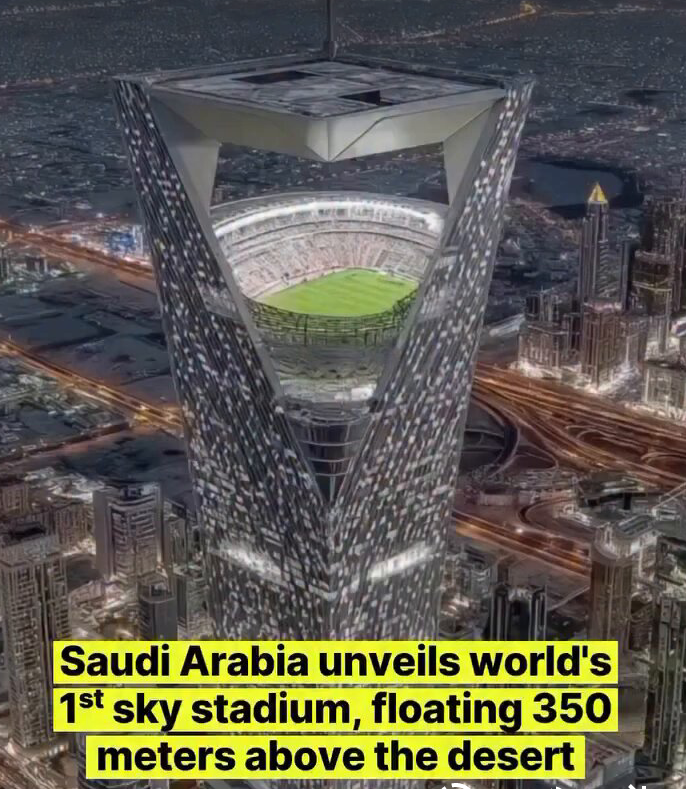

In a move that once again places Saudi Arabia at the center of global architectural innovation and sporting ambition, the Kingdom has announced plans to construct the world’s first-ever “sky stadium,” a groundbreaking venue that will literally hang in the clouds. Set to be suspended 1,150 feet above the ground, this futuristic arena is expected to open its gates around 2032 and serve as one of the showpiece venues for the 2034 FIFA World Cup, which Saudi Arabia is preparing to host. The announcement has sent shockwaves through the global sports community, as the country continues to redefine the limits of engineering, entertainment, and ambition.
According to early concept visuals and development outlines released by the Saudi Ministry of Sports, the sky stadium will combine state-of-the-art technology, luxurious amenities, and sustainable engineering to create a one-of-a-kind sports and entertainment experience. It will not only be a stadium but a living symbol of the nation’s audacious “Vision 2030” plan — a long-term blueprint designed to diversify Saudi Arabia’s economy beyond oil and establish it as a global hub for tourism, sports, and innovation.
While the exact location of the sky stadium has not yet been publicly confirmed, sources close to the project suggest that it could be integrated within the NEOM megacity — Saudi Arabia’s highly publicized $500 billion futuristic urban development along the Red Sea coast. NEOM, already home to mind-bending projects like “The Line” (a 170-kilometer linear city with mirrored walls) and “Trojena” (a year-round ski resort in the desert), is being positioned as the ultimate showcase of human creativity and technological mastery. The sky stadium, many observers believe, would be the crown jewel of this vision.
What makes the concept so jaw-dropping is not just its height, but its entire design philosophy. Engineers plan to suspend the massive structure in the sky using advanced architectural and structural systems that have never been attempted on this scale before. It’s expected to utilize a combination of mega-support towers, ultra-lightweight materials, and possibly magnetic or drone-based stabilizing technology to ensure safety and stability even at extreme heights. From that altitude, spectators would be treated to panoramic views of the surrounding desert landscape, the sea, and the skyline — making every match a spectacle both on and off the pitch.
The announcement comes at a time when Saudi Arabia has firmly established itself as a global player in sports, investing heavily across multiple disciplines. Over the past few years, the Kingdom has hosted boxing championships, Formula 1 races, tennis tournaments, and even brought some of football’s biggest stars to its domestic league. With the 2034 FIFA World Cup now confirmed to take place in the Kingdom, this latest project further signals Saudi Arabia’s intention to host not just a tournament, but a futuristic sporting experience unlike anything the world has ever seen.
Reactions to the sky stadium plan have been mixed — a blend of astonishment, excitement, and skepticism. Supporters hail it as another bold statement from a nation determined to transform its image from oil dependency to innovation leadership. Many see it as a continuation of Saudi Arabia’s ongoing mission to build a global brand rooted in ambition and progress. For younger Saudis, especially, the idea of the world looking up — quite literally — to a Saudi-built marvel brings immense pride and a renewed sense of national identity.
However, critics have raised questions about feasibility, cost, and environmental impact. Engineering experts point out that maintaining a suspended stadium of that scale — complete with tens of thousands of spectators, utilities, and broadcast infrastructure — will require revolutionary technology in aerodynamics, structural engineering, and safety systems. Environmentalists, meanwhile, worry about the project’s carbon footprint, especially in a region already challenged by extreme temperatures and water scarcity. Some online users have even jokingly wondered what happens if a football goes “over the edge.”
Despite the skepticism, Saudi officials insist that the project will set new global standards for sustainable architecture. Early reports suggest that the sky stadium will be powered by renewable energy, incorporate smart temperature control systems, and utilize recycled materials in its construction. The design team, reportedly made up of international firms with experience in megastructures and green architecture, aims to make the stadium not just an engineering wonder but also a symbol of sustainable progress.
For sports fans and travelers, the prospect of attending a World Cup match more than a thousand feet above the ground feels like something straight out of science fiction. Imagine stepping into an elevator that ascends into the clouds, emerging into a floating arena where the roar of the crowd blends with the hum of technology and the winds of the Arabian desert. Luxury suites will likely feature floor-to-ceiling glass walls, digital displays embedded into seating, and possibly even augmented reality overlays that allow fans to see live stats or replays right before their eyes.
International reaction has been swift, with media outlets across Europe, Asia, and the Americas calling it “the boldest stadium concept in history.” FIFA representatives, while cautious about confirming specific venues so far ahead of the 2034 tournament, have reportedly expressed interest in supporting Saudi Arabia’s efforts to make the World Cup “a celebration of the future.” Given the Kingdom’s track record of completing massive infrastructure projects on tight timelines, many believe that the sky stadium might just become a reality sooner than expected.
In a global era where cities are competing to outdo one another in architectural brilliance, Saudi Arabia’s sky stadium could redefine what’s possible in sports infrastructure. For decades, the world’s most famous stadiums have been defined by their size, history, or design — from Wembley to Camp Nou to the Maracanã. But the idea of a stadium floating above the clouds introduces an entirely new dimension, one that shifts the definition of what a sports arena can be. It’s not just a place to watch games — it’s an experience, a statement, and a vision of humanity’s next frontier.
As construction timelines take shape and more details emerge, the world will be watching closely. Whether it’s seen as an engineering miracle or an extravagant dream, one thing is certain: the Saudi sky stadium has already succeeded in capturing the world’s imagination. It represents not only a milestone for Saudi Arabia but a moment in history where the boundaries of architecture, technology, and human ambition were pushed beyond the ordinary — into the sky itself.
By 2032, if all goes according to plan, fans may find themselves walking through the gates of a stadium like no other, suspended between earth and heaven, watching the world’s greatest footballers perform against a backdrop of clouds and stars. For now, the world can only look up — and wait.
🚨 Saudi Arabia is set to construct the world's first "sky stadium”. 🏟️
— Transfer News Live (@DeadlineDayLive) October 27, 2025
It will be suspended 1,150 feet above the ground, the venue is expected to open around 2032 and will host matches for the 2034 FIFA World Cup. 🇸🇦
https://t.co/LO7WE3RIMV


